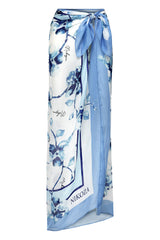Quick-Dry Swimwear: Designer Fabrics That Keep You Fresh & Comfortable
The Science Behind Quick-Dry Swimwear Fabric Technology
Quick-dry swimwear is a game-changer for anyone who loves to spend time in and around the water. It eliminates the discomfort of a soggy, heavy swimsuit and allows you to transition seamlessly from swimming to other activities.
But how does it work? The science behind quick-dry swimwear fabric technology is a fascinating combination of material science and textile engineering. It's all about creating a fabric that is hydrophobic, meaning it repels water, and has a structure that promotes rapid evaporation.
How Quick-Dry Swimwear Fabric Material Works
Quick-dry swimwear fabric works by minimizing the amount of water it can absorb. This is achieved through the use of synthetic fibers like polyester and nylon, which are naturally hydrophobic.
These fibers are tightly woven with low porosity, reducing water absorption even further. The fabric is also treated with a durable water repellent (DWR) finish, causing water to bead up and roll off the surface.
This combination of features ensures your swimsuit stays lightweight and comfortable, even when wet — a quality also appreciated in Luxury Beach Dresses designed for all-day freshness and style.
Moisture-Wicking vs. Water-Repelling Technologies
It's important to understand the difference between moisture-wicking and water-repelling technologies when it comes to quick-dry swimwear. Moisture-wicking fabrics are designed to draw sweat away from the skin and move it to the outer surface of the fabric, where it can evaporate.
This is a great feature for activewear, but it's not ideal for swimwear, as it can actually draw water into the fabric. Water-repelling fabrics, on the other hand, are designed to prevent water from penetrating the fabric in the first place.
This is the key to quick-dry swimwear, as it ensures that your swimsuit stays as dry as possible, both in and out of the water.
Essential Quick-Dry Swimwear Fabric Compositions
Polyester-Based Quick-Dry Swimwear Fabric
Polyester is the king of quick-dry swimwear fabric. It is a highly durable and hydrophobic fiber that is resistant to fading, stretching, and shrinking.
Polyester is also more resistant to chlorine than nylon, making it the best fabric for swimwear for those who spend a lot of time in chlorinated pools.
When blended with spandex, polyester creates a fabric that is both strong and stretchy, providing good support and shape retention. Look for polyester-based swimsuits with a high percentage of polyester for the best quick-dry performance.
Advanced Nylon Blends for Rapid Drying
While polyester is the top choice for quick-dry performance, advanced nylon blends are also a great option.
Nylon is a strong and durable fiber with a soft, smooth feel. When blended with spandex, it creates a fabric that is incredibly stretchy and form-fitting.
To boost its quick-dry ability, nylon is often treated with a durable water repellent (DWR) finish and woven to minimize water absorption.
These advanced nylon blends provide an ideal balance of comfort, style, and quick-dry performance.
Comfort-Enhancing Features in Modern Quick-Dry Fabrics
Antimicrobial Swimwear Lining Fabric Technologies
Comfort is key when it comes to swimwear, and modern quick-dry fabrics are designed with this in mind. One of the most important comfort-enhancing features is antimicrobial swimwear lining fabric.
This type of lining is treated with special agents that prevent the growth of bacteria, which can cause odors and skin irritation. An antimicrobial lining will keep your swimsuit — whether it’s a bikini or One Piece Swimwear — smelling fresh and feeling comfortable against your skin, even after a long day at the beach or pool.
Temperature-Regulating Fabric Innovations
Temperature-regulating fabric innovations are another exciting development in quick-dry swimwear. These fabrics are designed to help you stay cool and comfortable in hot weather.
They work by wicking away sweat and allowing it to evaporate quickly, which has a cooling effect on the skin. Some temperature-regulating fabrics also have a UPF rating of 50+, which provides excellent sun protection.
These innovative fabrics are a great choice for those who want to stay comfortable and protected from the sun while enjoying their time in the water.
The Best Fabric for Swimwear: Quick-Dry Performance Comparison
Synthetic vs. Natural Quick-Dry Materials
When it comes to quick-dry performance, synthetic materials are the clear winner. Synthetic fibers, such as polyester and nylon, are hydrophobic and have a low porosity, which means they absorb very little water.
Natural fibers, such as cotton and wool, are hydrophilic, which means they absorb a lot of water. This makes them a poor choice for swimwear, as they will become heavy and waterlogged when wet.
While some brands are experimenting with natural fiber blends for swimwear, synthetic materials are still the best fabric for swimwear when it comes to quick-dry performance.
Chlorine-Resistant Quick-Dry Formulations
For those who swim regularly in chlorinated pools, it's important to choose a quick-dry swimsuit that is also chlorine-resistant. Chlorine can quickly degrade traditional swimwear fabrics, causing them to fade, stretch, and lose their shape.
Chlorine-resistant quick-dry formulations are made from fibers that are inherently resistant to chlorine, such as polyester. This durability makes them ideal for a variety of styles, including one-shoulder swimwear. They are also treated with special coatings that provide an extra layer of protection.
These formulations will ensure that your swimsuit maintains its quick-dry performance and its vibrant color for longer.
2025 Innovations in Quick-Dry Swimwear Fabric Material
Sustainable Quick-Dry Technologies
The swimwear industry is constantly evolving, and 2025 has brought some exciting innovations in quick-dry swimwear fabric material. One of the most significant trends is the development of sustainable quick-dry technologies.
Brands are now using recycled polyester and nylon to create swimwear fabrics that are both high-performing and eco-friendly.
Some brands are also experimenting with bio-based DWR finishes, which are made from renewable resources and are biodegradable. These sustainable innovations are a great way to enjoy the latest swimwear trends while also minimizing your environmental impact.
Smart Fabric Integration and Performance Monitoring
Smart fabric integration is another exciting development in quick-dry swimwear. Some brands are now embedding sensors into their swimwear fabrics that can monitor your performance in the water.
These sensors can track your heart rate, distance, and speed, and provide you with real-time feedback on your swimming technique. This is a great feature for competitive swimmers and fitness enthusiasts who want to take their training to the next level, and it pairs perfectly with modern swim essentials like Beach Cover Ups for comfort outside the water.
While this technology is still in its early stages, it has the potential to revolutionize the way we think about swimwear.
Choosing and Caring for Quick-Dry Swimwear
What Fabric is Swimwear Made Of: Selection Guide
When choosing a quick-dry swimsuit, it's important to consider your needs and preferences. Here are a few things to keep in mind:
• Activity Level: If you're a competitive swimmer, you'll want to choose a swimsuit made from a durable and chlorine-resistant fabric, such as a polyester-spandex blend. If you're more of a leisurely sunbather, a soft and comfortable nylon-spandex blend is a great option.
• Fit: A well-fitting swimsuit will not only look better but also perform better. Make sure to try on a few different styles to find one that fits you perfectly.
• Features: Consider what features are important to you. Do you want a swimsuit with a UPF rating of 50+? Do you want a swimsuit with an antimicrobial lining? Make a list of your must-have features before you start shopping.
Maintenance Tips for Long-Lasting Quick-Dry Performance
To ensure that your quick-dry swimsuit lasts as long as possible, it's important to care for it properly. Here are a few tips:
• Rinse after each use: Always rinse your swimsuit in cool water after each wear to remove any chlorine, saltwater, or sunscreen.
• Hand wash: Hand wash your swimsuit with a mild detergent and lay it flat to dry in a shaded area.
• Avoid the dryer: Never put your swimsuit in the dryer, as the heat can damage the delicate fibers and reduce its quick-dry performance.
Quick-Dry Performance Comparison Table
|
Fabric Type |
Dry Time |
Water Absorption |
Chlorine Resistance |
Comfort Level |
|
Polyester-Spandex |
15-30 minutes |
Very Low |
Excellent |
Good |
|
Nylon-Spandex |
20-45 minutes |
Low |
Good |
Excellent |
|
Cotton Blend |
2-4 hours |
High |
Poor |
Very Good |
|
Recycled Polyester |
15-30 minutes |
Very Low |
Excellent |
Good |
2025 Quick-Dry Technology Highlights
The latest advancements in quick-dry swimwear fabric material for 2025 include:
• SILVADUR™ Antimicrobial Technology: Advanced silver-based treatments that prevent bacterial growth and odor formation.
• Bio-Based DWR Finishes: Environmentally friendly water-repellent treatments made from renewable resources.
• Enhanced Moisture Management: Improved fiber structures that accelerate evaporation rates by up to 40%.
• Smart Fabric Integration: Embedded sensors for performance monitoring and health tracking.
• Recycled Ocean Plastic: Innovative use of ocean waste in high-performance quick-dry fabrics.
Benefits of Quick-Dry Swimwear Technology
Understanding what fabric swimwear is made of when it comes to quick-dry technology reveals numerous benefits:
Immediate Comfort: Quick-dry fabrics eliminate the clammy, uncomfortable feeling of wet swimwear against your skin. This is particularly beneficial when transitioning from water activities to other pursuits.
Reduced Chafing: Wet fabric can cause painful chafing during movement. Quick-dry materials minimize this risk by reducing the time your skin is in contact with damp fabric.
Temperature Regulation: Quick-dry fabrics help maintain optimal body temperature by preventing the cooling effect of prolonged moisture contact, which can be especially important in air-conditioned environments. This benefit is particularly valued in stylish options like Designer Bikini Sets, where both comfort and performance matter.
Hygiene Benefits: Faster drying times reduce the opportunity for bacteria and fungi to grow, promoting better hygiene and reducing the risk of skin infections.
Versatility: Quick-dry swimwear allows for seamless transitions between activities, making it perfect for active vacations and multi-sport days.
Final Thoughts on Quick-Dry Swimwear
The evolution of quick-dry swimwear fabric technology represents a significant advancement in comfort and performance.
As we move through 2025, the integration of sustainable materials, smart technologies, and enhanced comfort features continues to push the boundaries of what's possible in swimwear design.
Whether you're a competitive athlete seeking peak performance or a leisure swimmer prioritizing comfort, understanding the science behind quick-dry fabrics empowers you to make informed choices.
The best fabric for swimwear ultimately depends on your specific needs, but quick-dry technology offers benefits that enhance any aquatic experience.
By investing in quality quick-dry swimwear — especially styles highlighted in our guide to the Most Comfortable Designer Swimwear — and following proper care guidelines, you can enjoy the freedom and comfort that comes with staying fresh and dry, no matter how much time you spend in the water.

